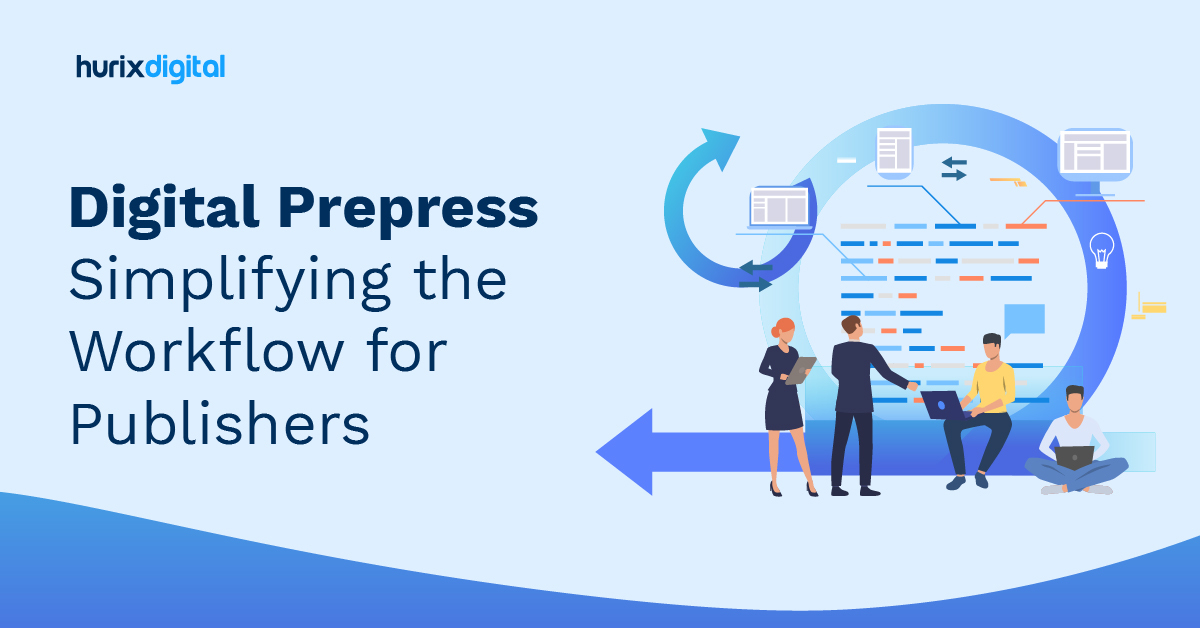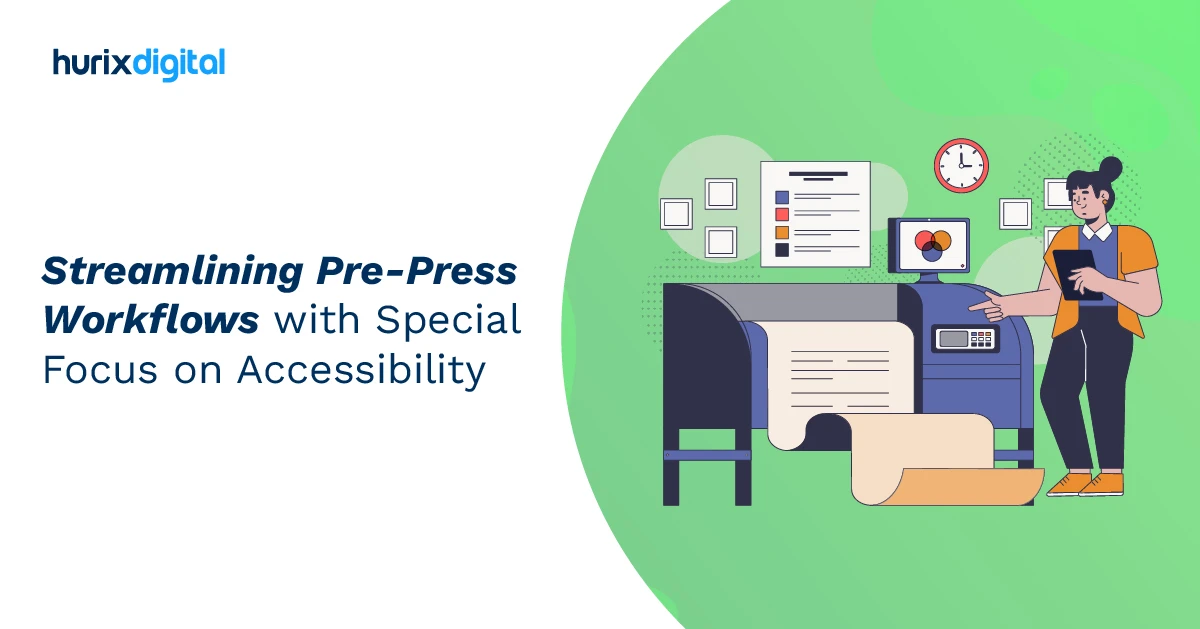
Digital Prepress – Simplifying the Workflow for Publishers
Summarize with:
By 2032, the worldwide market for digital printing packaging is projected to grow from its 2023 valuation of USD 24.15 billion to USD 56.03 billion. This indicates a 9.8% compound annual growth rate (CAGR) from 2023 to 2032. Digital prepress technology excels as a major contributing factor to this market size. The publishing industry constantly evolves, with efficiency and speed playing a fundamental role.
From file preparation to print-ready production, the prepress workflow ensures stepwise optimization for publishers to have their products launched without losing quality.
This blog explores how prepress technology streamlines workflow and helps publishers move forward with these new efficiencies.
Table of Contents:
- What is Digital Prepress?
- Digital Prepress Process Requirements
- The Digital Prepress Processes
- How Digital Prepress Technology Simplifies Workflow?
- Key Benefits of Digital Prepress Technology
- Takeaway
What is Digital Prepress?
The term “pre-press” is used to describe the process of preparing files for a printing press, making them ready for printing. “Digital Prepress” is the new era terminology replacing the traditional term with digital preparation of files for printing.
The availability of graphics and page composition programs makes design work much easier and faster. With digital processing, accomplishing the page layout is no longer a strenuous job. It is possible to send and exchange documents electronically, eliminating the time and costs of physical delivery.
Also Read: What is Typesetting and Why it is Important?
Digital Prepress Process Requirements
In digital processing, the electronic outputs are usually in the form of PDFs or application files with different file sizes and file types, which may impact the effectiveness of the digital pre-press, therefore, it is prudent to utilize a trained prepress technician to provide competent results, quickly and efficiently.
The Digital Prepress Processes
The digital pre-press process usually starts immediately after the word manuscripts are submitted to the prepress company. Let us have a look at the processes that follow.
1. Copyediting
This is to ensure consistency in the written work, making sure the content is fair and sensible, and refining the content without altering the original intent. This process also includes formatting the content to the publisher’s house style using customized publisher-specific automation tools and services offered by clients.
2. Typesetting
This involves creating a proof, that is, designing a layout using one of the leading design applications, for example, Adobe InDesign, QuarkXPress, and Arbortext (3B2), to name a few. The correction cycle includes image retouching, for which Adobe Photoshop is the leading application.
3. Proofreading
This is the penultimate step taken before a document is published. Formatting and typographical errors are checked. This step also ensures the document adheres to the design/layout style guide.
4. Digital Structuring of the Content
The last step is to structure the text for the final display. This is done using Markup language, which is a means to give instructions about the layout of how the text of the document or book will be displayed.
5. Pre-Flighting
Before the finished pages go through the remaining processes, a validation is done to check whether all the data meets the necessary printer requirements.
6. Creating High-Quality Print Files
This is the process of creating a high-resolution PDF that meets all the specifications to produce a high-quality print.
7. Digital Prepress Checklist
The sequence of procedures followed in a digital prepress collectively constitutes a workflow. Each workflow process is unique with the preferred use of technologies. Whatever the workflow is, the bottom line is that every step of the process has to be carefully managed, which requires collective participation and coordination from each of the digital prepress processes mentioned.
How Digital Prepress Technology Simplifies Workflow?
Digital prepress technology has helped streamline workflows and enhance efficiency in the following ways:
1. Automate File Preparation
Film organizing and plate creation were two of the several manual procedures traditionally included in the prepress process. These steps were labor-intensive and prone to mistakes.
Thanks to digital prepress, publishers can now transform digital files straight into print-ready forms, saving a lot of time.
2. Enhances Real-time Collaboration
One of digital pre-press’s main benefits is its potential to enable real-time collaboration. Publishers can easily share files with printers, editors, and designers, enabling quick edits and feedback.
By working together, printing houses can reduce misunderstandings and ensure that everyone involved is on the same page throughout the production process.
3. Ensures Consistent Quality Across Print Runs
Digital pre-press technology automates several processes, including color correction, proofreading, and imposition. Automated workflows lower the possibility of human mistakes and guarantee constant quality over print runs.
Digital asset management systems are another tool that publishers can use to effectively organize and retrieve assets.
4. Supports A Wide Range of Print Formats
With the backing of digital pre-press, publishers can swiftly adjust to market needs by offering a variety of print formats and on-demand printing.
Key Benefits of Digital Prepress Technology
Some of the main advantages of digital pre-press workflow that significantly enhance the publishing process are as follows:
1. Improved Accuracy
Digital pre-press systems use advanced technological innovations to capture errors at the print level. This ensures high-quality output while maintaining consistency across different projects.
2. Cost-Savings
Digital pre-press reduces the effort and material waste associated with traditional prepress techniques. Publishers can print on demand, optimizing resource usage by producing only what is needed.
3. Faster Turnaround Times
Digital prepress enables publishers to eliminate backbreaking, time-consuming manual processes despite working under close-to-impossible timelines. Digital files can be easily shared and reviewed by stakeholders in real-time, allowing for quick modifications and feedback.
Also Read: Best Printing Software and Prepress Tools for Professional Printing in 2024
Takeaway
Digital prepress has become the preferred choice for publishers to print on demand. In fact, the market share of digital printing has almost doubled over the last decade. Electronic publishing is advantageous over traditional publishing as it is cost-effective and provides a better reader experience.
Experience the benefits of digital printing with Hurix Digital. From efficient copyediting to indexing, we provide a full suite of prepress solutions to elevate your publishing journey. If you want to know more about the various functionalities and benefits of digital prepress, we are happy to help you!
Summarize with:

Vice President – Content Transformation at HurixDigital, based in Chennai. With nearly 20 years in digital content, he leads large-scale transformation and accessibility initiatives. A frequent presenter (e.g., London Book Fair 2025), Gokulnath drives AI-powered publishing solutions and inclusive content strategies for global clients
 A Space for Thoughtful
A Space for Thoughtful 



